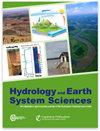推进南加州沿海未开发流域的河流分类和水文建模,用于环境流量管理
IF 5.8
1区 地球科学
Q1 GEOSCIENCES, MULTIDISCIPLINARY
引用次数: 0
摘要
摘要环境水流管理可以通过将经过改造的水流恢复到更自然的状态来改善河流的生态健康。用于制定区域环境流量标准的水文变化生态极限(ELOHA)框架已经实施,以逆转南加州沿海非均质区域的加氢作用(So。CA)通过关注流态的两个元素:流的持久性和闪光性。在ELOHA中,根据水文和地貌相似性对河流进行分类,以分层水流-生态学关系。水文建模者使用类似的分组技术,通过分区来促进未开发流域(PUB)的流量预测。大多数流域,包括河流分类和环境流动发展所需要的流域,都没有被破坏。此外,所以。中亚是一个高度非均匀的区域,跨越了城市化和流动持久性的梯度,这对未开发盆地的区划提出了挑战。在这项研究中,我们开发了一种新的PUB建模分类技术,该技术使用归纳方法通过模拟水文相似性对多年生、间歇和短暂的区域河流进行分组,然后通过水文模型误差和流域指标演绎确定类别成员。作为一种新型的分类方法,基于水文模型的分类(HMC)优先考虑了建模的准确性,这反过来又为改进未开发流域的模型预测提供了一种手段,同时补充了传统分类方法,改善了环境流量管理。HMC是通过校准基于过程的降雨径流模型的区域目录,量化未开发流域中未知的校准参数的水文互易性,并根据水文和物理相似性对站点进行分组而开发的。HMC应用于加利福尼亚“南海岸”地区的25个USGS流量测量,并与其他结合归纳和演绎分类的混合PUB方法进行了比较。使用平均聚类误差度量,结果表明,根据校准的参数互易性,HMC提供了最多的水文相似组。基于水文模型的分类相对复杂且耗时,但它显示出简化未开发流域管理的潜力。本研究论证了采用多种方法对河流进行全面分类的好处,并指出基于水文模型的分类对PUB和建立环境流量管理的水文基础具有优势。本文章由计算机程序翻译,如有差异,请以英文原文为准。
Advancing stream classification and hydrologic modeling of ungaged basins for environmental flow management in coastal southern California
Abstract. Environmental streamflow management can improve the ecological health of streams by returning modified flows to more natural conditions. The Ecological Limits of Hydrologic Alteration (ELOHA) framework for developing regional environmental flow criteria has been implemented to reverse hydromodification across the heterogenous region of coastal southern California (So. CA) by focusing on two elements of the flow regime: streamflow permanence and flashiness. Within ELOHA, classification groups streams by hydrologic and geomorphic similarity to stratify flow–ecology relationships. Analogous grouping techniques are used by hydrologic modelers to facilitate streamflow prediction in ungaged basins (PUB) through regionalization. Most watersheds, including those needed for stream classification and environmental flow development, are ungaged. Furthermore, So. CA is a highly heterogeneous region spanning gradients of urbanization and flow permanence, which presents a challenge for regionalizing ungaged basins. In this study, we develop a novel classification technique for PUB modeling that uses an inductive approach to group perennial, intermittent, and ephemeral regional streams by modeled hydrologic similarity followed by deductively determining class membership with hydrologic model errors and watershed metrics. As a new type of classification, this hydrologic-model-based classification (HMC) prioritizes modeling accuracy, which in turn provides a means to improve model predictions in ungaged basins while complementing traditional classifications and improving environmental flow management. HMC is developed by calibrating a regional catalog of process-based rainfall–runoff models, quantifying the hydrologic reciprocity of calibrated parameters that would be unknown in ungaged basins and grouping sites according to hydrologic and physical similarity. HMC was applied to 25 USGS streamflow gages in the “South Coast” region of California and was compared to other hybrid PUB approaches combining inductive and deductive classification. Using an average cluster error metric, results show that HMC provided the most hydrologically similar groups according to calibrated parameter reciprocity. Hydrologic-model-based classification is relatively complex and time-consuming to implement, but it shows potential for simplifying ungaged basin management. This study demonstrates the benefits of thorough stream classification using multiple approaches and suggests that hydrologic-model-based classification has advantages for PUB and building the hydrologic foundation for environmental flow management.
求助全文
通过发布文献求助,成功后即可免费获取论文全文。
去求助
来源期刊

Hydrology and Earth System Sciences
地学-地球科学综合
CiteScore
10.10
自引率
7.90%
发文量
273
审稿时长
15 months
期刊介绍:
Hydrology and Earth System Sciences (HESS) is a not-for-profit international two-stage open-access journal for the publication of original research in hydrology. HESS encourages and supports fundamental and applied research that advances the understanding of hydrological systems, their role in providing water for ecosystems and society, and the role of the water cycle in the functioning of the Earth system. A multi-disciplinary approach is encouraged that broadens the hydrological perspective and the advancement of hydrological science through integration with other cognate sciences and cross-fertilization across disciplinary boundaries.
 求助内容:
求助内容: 应助结果提醒方式:
应助结果提醒方式:


